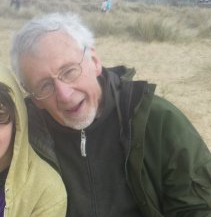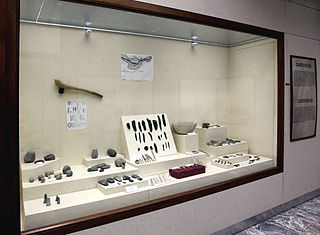
The Neolithic or New Stone Age is an archaeological period, the final division of the Stone Age in Europe, Asia and Africa. It saw the Neolithic Revolution, a wide-ranging set of developments that appear to have arisen independently in several parts of the world. This "Neolithic package" included the introduction of farming, domestication of animals, and change from a hunter-gatherer lifestyle to one of settlement. The term 'Neolithic' was coined by Sir John Lubbock in 1865 as a refinement of the three-age system.
Tell Abu Hureyra is a prehistoric archaeological site in the Upper Euphrates valley in Syria. The tell was inhabited between 13,000 and 9,000 years ago in two main phases: Abu Hureyra 1, dated to the Epipalaeolithic, was a village of sedentary hunter-gatherers; Abu Hureyra 2, dated to the Pre-Pottery Neolithic, was home to some of the world's first farmers. This almost continuous sequence of occupation through the Neolithic Revolution has made Abu Hureyra one of the most important sites in the study of the origins of agriculture.

Einkorn wheat can refer either to a wild species of wheat (Triticum) or to its domesticated form. The wild form is T. boeoticum, and the domesticated form is T. monococcum. Einkorn is a diploid species of hulled wheat, with tough glumes ('husks') that tightly enclose the grains. The cultivated form is similar to the wild, except that the ear stays intact when ripe and the seeds are larger. The domestic form is known as "petit épeautre" in French, "Einkorn" in German, "einkorn" or "littlespelt" in English, "piccolo farro" in Italian and "escanda menor" in Spanish. The name refers to the fact that each spikelet contains only one grain.

Pre-Pottery Neolithic A (PPNA) denotes the first stage of the Pre-Pottery Neolithic, in early Levantine and Anatolian Neolithic culture, dating to c. 12,000 – c. 10,800 years ago, that is, 10,000–8800 BCE. Archaeological remains are located in the Levantine and Upper Mesopotamian region of the Fertile Crescent.

Pre-Pottery Neolithic B (PPNB) is part of the Pre-Pottery Neolithic, a Neolithic culture centered in upper Mesopotamia and the Levant, dating to c. 10,800 – c. 8,500 years ago, that is, 8800–6500 BC. It was typed by British archaeologist Kathleen Kenyon during her archaeological excavations at Jericho in the West Bank.

The founder crops or primary domesticates are a group of flowering plants that were domesticated by early farming communities in Southwest Asia and went on to form the basis of agricultural economies across Eurasia. As originally defined by Daniel Zohary and Maria Hopf, they consisted of three cereals, four pulses, and flax. Subsequent research has indicated that many other species could be considered founder crops. These species were amongst the first domesticated plants in the world.
Mureybet is a tell, or ancient settlement mound, located on the west bank of the Euphrates in Raqqa Governorate, northern Syria. The site was excavated between 1964 and 1974 and has since disappeared under the rising waters of Lake Assad. Mureybet was occupied between 10,200 and 8,000 BC and is the eponymous type site for the Mureybetian culture, a subdivision of the Pre-Pottery Neolithic A (PPNA). In its early stages, Mureybet was a small village occupied by hunter-gatherers. Hunting was important and crops were first gathered and later cultivated, but they remained wild. During its final stages, domesticated animals were also present at the site.

Gordon Hillman was a British archaeobotanist and academic at the UCL Institute of Archaeology. He has been described as "a pivotal figure in the development of archaeobotany at the Institute of Archaeology at University College London, [who] through his research, publications and teaching had a major influence on the field worldwide."

The Pre-Pottery Neolithic (PPN) represents the early Neolithic in the Levantine and upper Mesopotamian region of the Fertile Crescent, dating to c. 12,000 – c. 8,500 years ago,. It succeeds the Natufian culture of the Epipalaeolithic Near East, as the domestication of plants and animals was in its formative stages, having possibly been induced by the Younger Dryas.
Tell Aswad, Su-uk-su or Shuksa, is a large prehistoric, neolithic tell, about 5 hectares (540,000 sq ft) in size, located around 48 kilometres (30 mi) from Damascus in Syria, on a tributary of the Barada River at the eastern end of the village of Jdeidet el Khass.

Henri de Contenson was a French archaeologist and a researcher at the CNRS, The Centre National de la Recherche Scientifique, a research organization funded by France's Ministry of Research.
Danielle Stordeur is a French Archaeologist and Directeur de Recherche at the CNRS. She is also Director of the French Ministry of Foreign Affairs permanent mission to El Kowm-Mureybet (Syria), replacing Jacques Cauvin in 1993 until 2010, when Frédéric Abbès is due to take over this position.
El Kowm or Al Kawm is a circular, 20 km (12 mi) gap in the Syrian mountains that houses a series of archaeological sites. The El Kowm oasis is located northeast of Palmyra in Syria, near Al-Sukhnah. It shows some of the longest and most important cultural sequences in the Middle East, with periods of occupation by humans for over 1 million years.
Frédéric Abbès is a French archaeologist working on postdoctoral research, specialising in the stone or lithic industry of the Near East and Mediterranean. He has worked on important archaeological sites such as Tell Aswad and El Kowm.
Professor Jacques Cauvin was a French archaeologist who specialised in the prehistory of the Levant and Near East.

Jerf el Ahmar is a Neolithic site in northern Syria, which dated back between 9,200 and 8,700 BC.

Cafer Hoyuk or Cafer Höyük is an archaeological site located around 40 kilometres (25 mi) northeast of Malatya, Turkey in the Euphrates valley. It was inhabited over ten thousand years ago during the Neolithic revolution.
Glynis Eleanor Jones FBA is a British archaeobotanist, who is Professor of Archaeology at the University of Sheffield.
The International Work Group for Palaeoethnobotany (IWGP) is an informal, international collective of archaeobotanists, with the main goal of establishing and maintaining international communication and collaboration by a series of conferences. These conferences focus mainly, but not exclusively, on the study of plant macrofossils in order to reconstruct past subsistence, trade, construction, ritual, and the environment.







